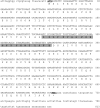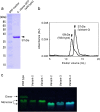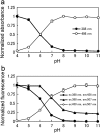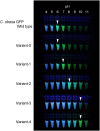Dual-color-emitting green fluorescent protein from the sea cactus Cavernularia obesa and its use as a pH indicator for fluorescence microscopy
- PMID: 23468077
- PMCID: PMC3884763
- DOI: 10.1002/bio.2497
Dual-color-emitting green fluorescent protein from the sea cactus Cavernularia obesa and its use as a pH indicator for fluorescence microscopy
Abstract
We isolated and characterized a green fluorescent protein (GFP) from the sea cactus Cavernularia obesa. This GFP exists as a dimer and has absorption maxima at 388 and 498 nm. Excitation at 388 nm leads to blue fluorescence (456 nm maximum) at pH 5 and below, and green fluorescence (507 nm maximum) at pH 7 and above, and the GFP is remarkably stable at pH 4. Excitation at 498 nm leads to green fluorescence (507 nm maximum) from pH 5 to pH 9. We introduced five amino acid substitutions so that this GFP formed monomers rather than dimers and then used this monomeric form to visualize intracellular pH change during the phagocytosis of living cells by use of fluorescence microscopy. The intracellular pH change is visualized by use of a simple long-pass emission filter with single-wavelength excitation, which is technically easier to use than dual-emission fluorescent proteins that require dual-wavelength excitation.
Keywords: GFP, dual-color emission; fluorescence microscopy; pH indicator; sea cactus.
Copyright © 2013 John Wiley & Sons, Ltd.
Figures









Similar articles
-
The first mutant of the Aequorea victoria green fluorescent protein that forms a red chromophore.Biochemistry. 2008 Apr 22;47(16):4666-73. doi: 10.1021/bi702130s. Epub 2008 Mar 27. Biochemistry. 2008. PMID: 18366185 Free PMC article.
-
Color transitions in coral's fluorescent proteins by site-directed mutagenesis.BMC Biochem. 2001;2:6. doi: 10.1186/1471-2091-2-6. Epub 2001 Jul 10. BMC Biochem. 2001. PMID: 11459517 Free PMC article.
-
Dual color microscopic imagery of cells expressing the green fluorescent protein and a red-shifted variant.Gene. 1996;173(1 Spec No):19-23. doi: 10.1016/0378-1119(95)00781-4. Gene. 1996. PMID: 8707051
-
Green fluorescent protein based pH indicators for in vivo use: a review.Anal Bioanal Chem. 2009 Feb;393(4):1107-22. doi: 10.1007/s00216-008-2515-9. Epub 2008 Nov 26. Anal Bioanal Chem. 2009. PMID: 19034433 Review.
-
Tumor imaging with multicolor fluorescent protein expression.Int J Clin Oncol. 2011 Apr;16(2):84-91. doi: 10.1007/s10147-011-0201-y. Epub 2011 Feb 25. Int J Clin Oncol. 2011. PMID: 21347627 Review.
Cited by
-
Insights into the bioluminescence systems of three sea pens (Cnidaria: Anthozoa): from de novo transcriptome analyses to biochemical assays.Open Biol. 2025 Apr;15(4):240262. doi: 10.1098/rsob.240262. Epub 2025 Apr 30. Open Biol. 2025. PMID: 40300651 Free PMC article.
-
Genetically Encoded Ratiometric pH Sensors for the Measurement of Intra- and Extracellular pH and Internalization Rates.Biosensors (Basel). 2022 Apr 25;12(5):271. doi: 10.3390/bios12050271. Biosensors (Basel). 2022. PMID: 35624572 Free PMC article.
-
Voltammetric pH Measurements Using Azure A-Containing Layer-by-Layer Film Immobilized Electrodes.Polymers (Basel). 2020 Oct 12;12(10):2328. doi: 10.3390/polym12102328. Polymers (Basel). 2020. PMID: 33053708 Free PMC article.
-
Progress in pH-Sensitive sensors: essential tools for organelle pH detection, spotlighting mitochondrion and diverse applications.Front Pharmacol. 2024 Jan 10;14:1339518. doi: 10.3389/fphar.2023.1339518. eCollection 2023. Front Pharmacol. 2024. PMID: 38269286 Free PMC article. Review.
-
A direct experimental test of Ohno's hypothesis.Elife. 2025 Apr 2;13:RP97216. doi: 10.7554/eLife.97216. Elife. 2025. PMID: 40172958 Free PMC article.
References
-
- Haddock SHD, Moline MA, Case JF. Bioluminescence in the sea. Annu Rev Mar Sci. 2010;2:443–93. - PubMed
-
- Shimomura O. Bioluminescence: chemical principles and methods. Singapore: World Scientific Publishing; 2006.
-
- Tsien RY. The green fluorescent protein. Annu Rev Biochem. 1998;67:509–44. - PubMed
-
- Miyawaki A, Llopis J, Heim R, McCaffery JM, Adams JA, Ikura M, et al. Fluorescent indicators for Ca2+ based on green fluorescent proteins and calmodulin. Nature. 1997;388:882–7. - PubMed
MeSH terms
Substances
Associated data
- Actions
- Actions
- Actions
LinkOut - more resources
Full Text Sources
Other Literature Sources
Research Materials

